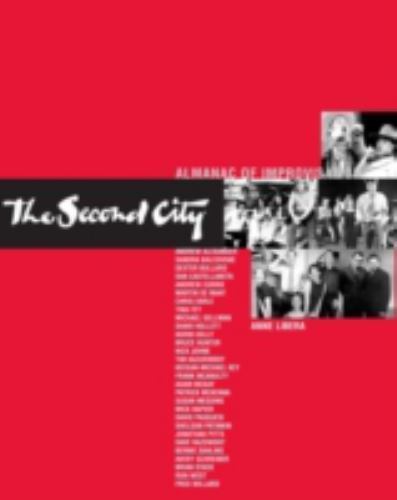Picture 1 of 1

Stock photo

Picture 1 of 1

Stock photo

Second City Almanac of Improvisation by Anne Libera (2004, Trade Paperback)

AlibrisBooks (459849)
98.6% positive feedback
Price:
$84.32
Free shipping
Returns:
30 days returns. Buyer pays for return shipping. If you use an eBay shipping label, it will be deducted from your refund amount.
Condition:
New Trade paperback
Oops! Looks like we're having trouble connecting to our server.
Refresh your browser window to try again.
About this product
Product Identifiers
PublisherNorthwestern University Press
ISBN-100810118017
ISBN-139780810118010
eBay Product ID (ePID)30473840
Product Key Features
Book TitleSecond City Almanac of Improvisation
Number of Pages200 Pages
LanguageEnglish
TopicTheater / History & Criticism
Publication Year2004
IllustratorYes
GenrePerforming Arts
AuthorAnne Libera
FormatTrade Paperback
Dimensions
Item Height0.6 in
Item Weight20.8 Oz
Item Length10 in
Item Width8 in
Additional Product Features
Intended AudienceTrade
LCCN2004-002573
Reviews"Second City is not only a Chicago treasure, it's one of the most important theatre companies in the United States. Their legacy and commitment to improvisation and comedy is invaluable!" -Robert Falls, Artistic Director of The Goodman Theatre, "The alumni of Second City from John Belushi to Martin Short have changed my entire life and brought a new kind of comedy to America and the World." -Bernie Brillstein, Founding Partner of Brillstein-Grey Entertainment, "Second City teaches its actors what it means to be part of an ensemble. It's a technique that forces the actor to listen and be supportive during a scene. In an audition, I can always spot a Second City trained actor. First, I check their resume and then I observe an actor whose characters are well developed, honest and real." -Dick Blasucci, Executive Producer,MadTV, "Second City teaches its actors what it means to be part of an ensemble. It's a technique that forces the actor to listen and be supportive during a scene. In an audition, I can always spot a Second City trained actor. First, I check their resume and then I observe an actor whose characters are well developed, honest and real." -Dick Blasucci, Executive Producer, MadTV
Dewey Edition22
TitleLeadingThe
Dewey Decimal792.02/8
Table Of ContentForeword Preface Chapter One: Beginning Viola Spolin First Class The Rules Object Work, or "A Mime Is Not a Terrible Thing to Waste" Environment "Yes, and . . ." and "Explore and Heighten" Give and Take Where We Came From: A Very Brief History of Revue An Improvisational Almanac, Part One Chapter Two: Playing the Scene Martin Perfect Partner Relationship Relationship Exercises Transformation of Relationships Perfect Partner Part II Status Living Large in the Moment Play Is Physical An Improvisational Almanac, Part Two Chapter Three: The Performer inside the Scene A Few Thoughts on Improvisation Finding the Funny How Do You Create Characters? or "I Do This Hilarious Guy Who Has a Funny Hat" Three Kinds of Character Playing at the Top of Your Intelligence Character: Playing with Intelligence and Heart In the Beginning . . . Making Initiations Crossing the Line and Going Blue Forming Opinions Finding Scenic Point of View Finding Your Voice An Improvisational Almanac, Part Three Chapter Four: Improvisation and Acting Building a Character within an Ensemble through the Games An Improvisational Almanac, Part Four Chapter Five: Long Forms, Short Forms, Scenes, and Games Improvisation: The Fine Line between Suck and Not Bad and How to Get Away from That Line and Go to Another Line Where the Options Are Better Del Close Del Close Games What's Better? Long Form or Short Form? What Is Long-Form Improvisation? Scenic Structure 101 Don DePollo Top Ten Performance Games of The Second City National Touring Company Editing and Beats An Improvisational Almanac, Part Five Chapter Six: Creating Material Doing It Again Pre-Planning a Second City Scene The Ensemble Creates a Revue Putting Up a Traditional Second City Improv Set Blackouts and Extended Blackouts How to Bottle Lightning for Fun and Profit An Improvisational Almanac, Part Six Chapter Seven: Directing Blessed Obstacles Running Orders Ideal Running Order An Improvisational Almanac, Part Seven Recommended Reading Appendix Attributions Contributors Acknowledgments Contributors: Sandra Balcovske, Dexter Bullard, Andrew Currie, Chris Earle, Tina Fey, Shari Hollett, Bruce Hunter, Nick Johne, Tim Kazurinsky, Keegan-Michael Key, Kelly Leonard, Frank McAnulty, Adam McKay, Patrick McKenna, Susan Messing, Jonathan Pitts, David Razowsky, Jeff Richmond, Bernie Sahlins, Brian Stack, Ron West, Fred Willard.
SynopsisA Second City Almanac of Improvisation captures the information and wisdom about the art and practice of improvisation as developed and used during more than forty years of work, many glasses of scotch, and too many cups of wretched coffee at The Second City. This guide - like the theatre itself - is a collection of diverse ideas, viewpoints, and memories, written by a vast array of teachers, actors, and directors who all got their start at the legendary comedy theatre. Anne Libera walks the reader through each essay by providing a road map for understanding how the Second City method of improv-based comedy has become the industry standard., It all began in a converted Chinese laundry on Chicago's north side on a cold December night in 1959. No one could have known that by the next century, The Second City would have established itself as the premier comedy institution in the world. Taking its act north, The Second City would build a second permanent home in Toronto where it would create the Emmy-Award winning television series "SCTV." Pioneering the use of improvisation in developing talent and creating satiric revue comedy, The Second City has become - in the words of the New York Times - "A Comedy Empire." The Second City Almanac of Improvisation - like the theatre itself - is a collection of diverse ideas, viewpoints, and memories, written by a vast array of teachers, actors, and directors who all got their start at the legendary comedy theatre. Fred Willard recalls his introduction to The Second City style in the mid-Sixties; Tim Kazurinsky gives a hilarious visual demonstration on the art of object work; "Saturday Night Live" star Tina Fey talks about re-improvising material as a mode of writing revue comedy; noted director Mick Napier takes on the thorny debate between long-form improvisation and short-form improvisation. Anne Libera guides the reader through each essay by providing a road map for understanding how The Second City method of improv-based comedy has become the industry standard. Mike Nichols, Elaine May, Alan Arkin, Joan Rivers, Robert Klein, Peter Boyle, Harold Ramis, John Belushi, Dan Aykroyd, Bill Murray, John Candy, Martin Short, Gilda Radner, George Wendt, Jim Belushi, Bonnie Hunt, Mike Myers, Ryan Stiles, Rachel Dratch, Nia Vardalos - no other theatre can boast an alumni list of this magnitude. The Second City Almanac of Improvisation provides practical instruction, personal details, and inspiration to both improvisers and their fans.
LC Classification NumberPN2071.I5S43 2004
All listings for this product
Be the first to write a review

































